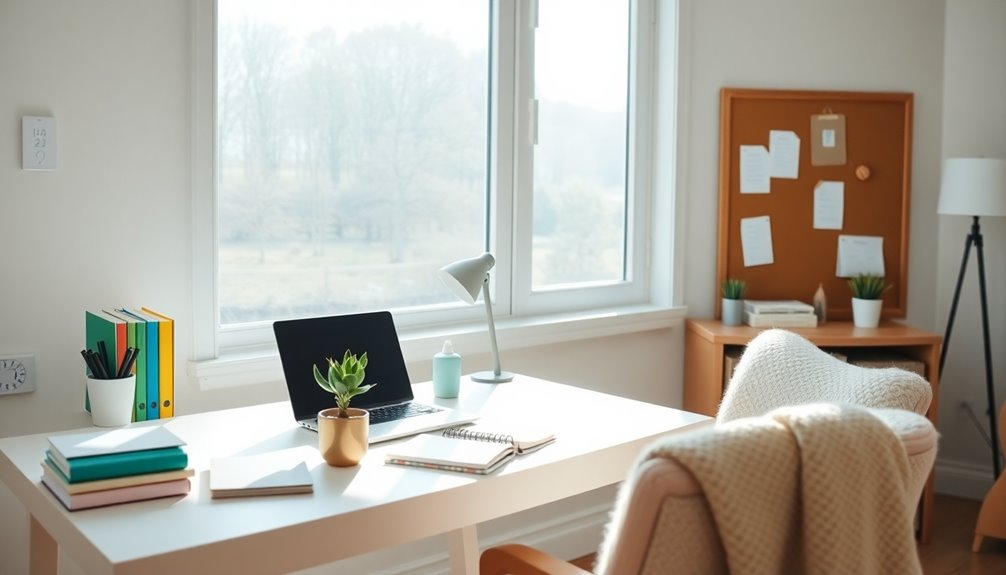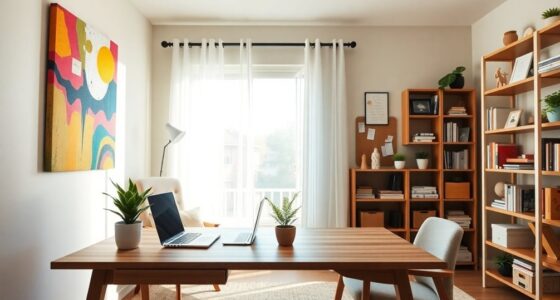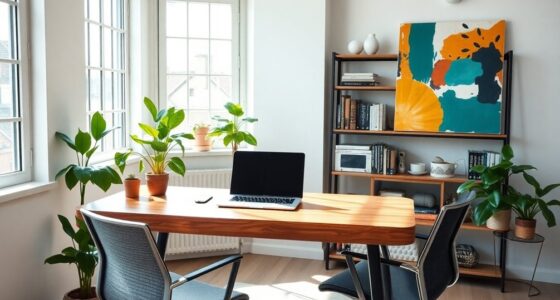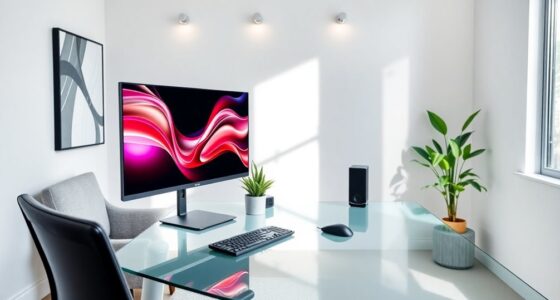Transforming your home office or study area from clutter to clarity doesn't have to be hard. Start by decluttering your workspace and designating zones for supplies. Utilize vertical space with wall-mounted shelves and pegboards. Implement a to-do list system to keep track of tasks and organize both digital and physical inboxes. Keep essential tools within reach and create a comfortable atmosphere. Embracing minimalism in your decor can also help. For even more tips, there's so much more to explore!
Key Takeaways
- Designate specific zones for supplies and utilize drawer organizers to keep items accountable and easily accessible.
- Implement a to-do list system to prioritize tasks and break larger projects into manageable steps.
- Utilize vertical space with wall-mounted shelves and pegboards to maximize workspace efficiency.
- Embrace minimalism by limiting decor to essentials and maintaining a cohesive color scheme for a serene environment.
- Regularly reassess organization by dedicating time weekly to declutter and refresh your workspace.
Declutter Your Workspace
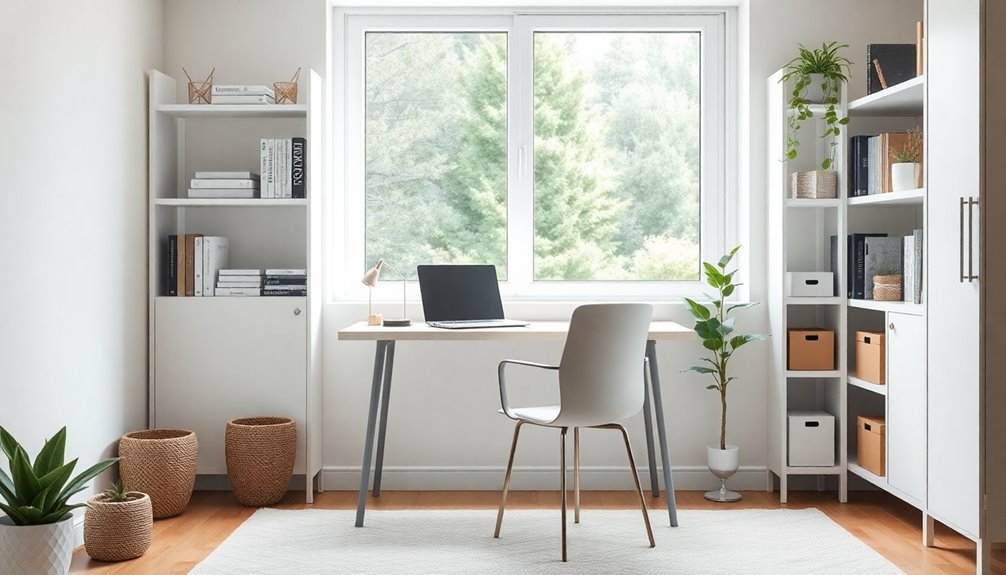
When you take a moment to declutter your workspace, you'll find that it can greatly boost your productivity. Clutter leads to distractions and hinders your ability to focus.
Start by gathering all loose papers into one designated file, making it easier to access important documents. Next, use a to-do list—whether on your smartphone or on paper—to keep track of daily tasks.
Assign a specific home for each item, ensuring desk supplies have designated zones to prevent clutter accumulation. Implement a routine for regular workspace assessments, eliminating unnecessary items to keep only what's essential.
Finally, clean your desk and electronics weekly with a microfiber cloth and disinfectant, promoting a fresh and organized environment for work.
Designate Zones for Supplies
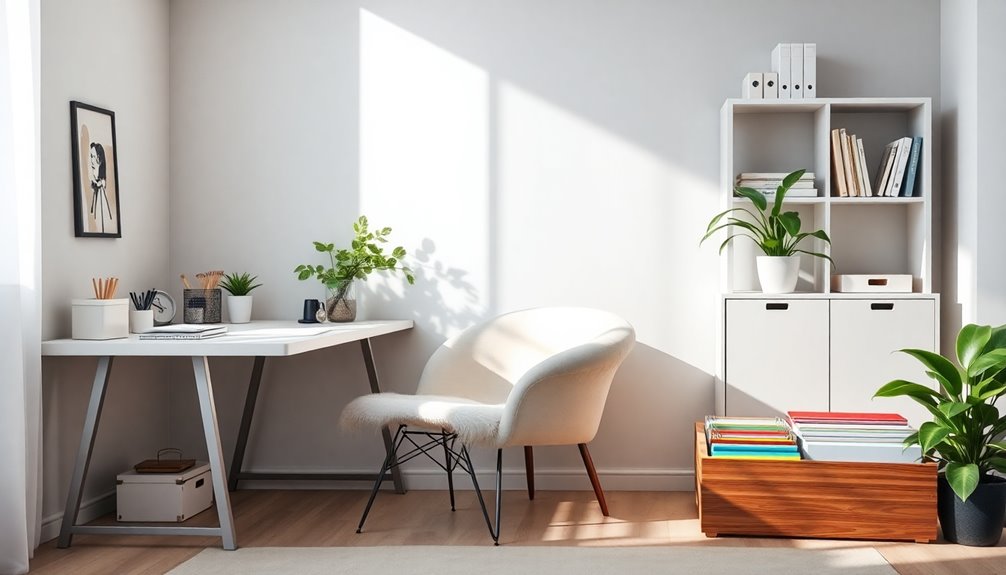
A well-organized workspace goes hand in hand with the efficient use of space for your supplies. To achieve this, make certain to designate specific zones for different categories of items. This will streamline access and keep your space organized.
Use drawer organizers for smaller items and label each zone clearly, promoting accountability. Consider these tips:
- Separate areas for writing instruments, paper products, and tech accessories
- Use baskets or bins for larger supplies like textbooks
- Regularly assess your zones to adapt to changing needs
- Keep sentimental items in a designated area to avoid clutter
- Guarantee everything is returned to its proper place after use
Additionally, creating designated zones will help maintain clarity and order in your workspace.
Utilize Vertical Space
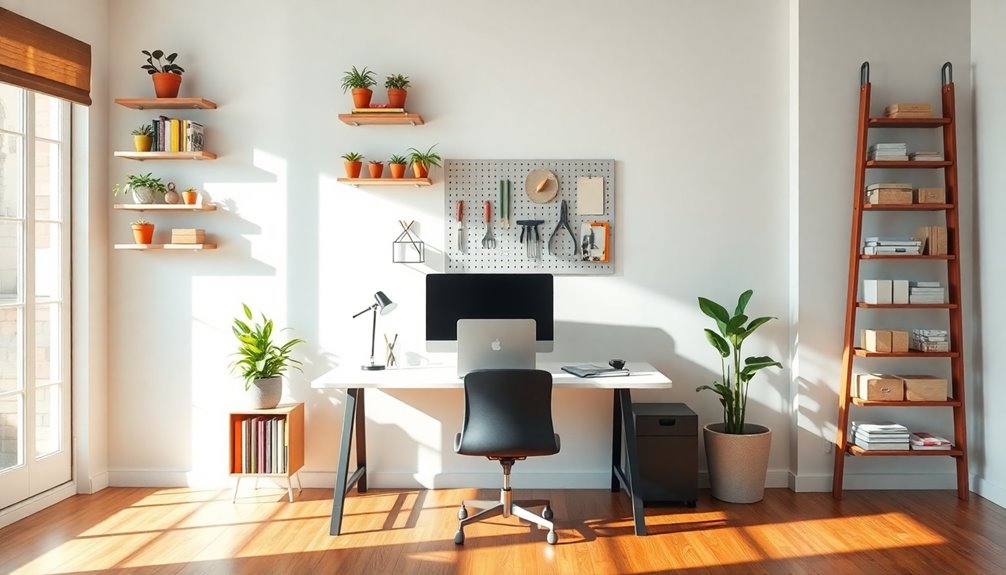
Maximizing vertical space can transform your home office into a more organized and efficient environment.
Start by installing wall-mounted shelves to display books, supplies, and decorative items, freeing up your desk and floor.
Pegboards are another great option for hanging tools or office supplies, creating an accessible and organized system.
Tall bookshelves can store materials vertically, allowing you to arrange items by type or color for easy access while keeping the floor clear.
Vertical file organizers are perfect for documents, saving desk space and keeping important items within reach.
Finally, adding hooks or wall racks can help you hang frequently used items like bags or headphones, contributing to a calming and orderly workspace.
Implement a To-Do List System

After you've optimized your vertical space, consider how a to-do list system can further enhance your home office productivity. A well-structured to-do list not only clarifies your daily tasks but also boosts your task management efficiency.
Research shows that writing down tasks increases the likelihood of completing them. Here are some tips to maximize your to-do list effectiveness:
- Choose between digital apps or traditional pen and paper
- Break larger tasks into smaller, actionable steps
- Regularly review and update your list
- Prioritize tasks based on urgency and importance
- Celebrate completed tasks to stay motivated
Additionally, remember that regularly reviewing your list can help you stay focused and adjust your priorities as needed.
Organize Digital and Physical Inboxes

To keep your digital and physical inboxes organized, start by streamlining your email subscriptions and implementing rules to sort incoming messages.
Schedule regular times each week to tackle your inbox, ensuring you stay on top of action items.
For physical paperwork, make quick decisions: act, trash, or file to maintain a clutter-free workspace. Additionally, consider setting up a budget plan to allocate time and resources effectively for ongoing organization efforts.
Streamline Email Unsubscriptions
While managing an overflowing inbox can feel overwhelming, streamlining your email unsubscribing process can lead to a more organized digital space.
Start by using tools like Unroll.me to quickly unsubscribe from unwanted lists, reducing clutter.
Consider creating a separate email account for subscriptions and shopping; this keeps promotional emails out of your primary inbox.
Schedule regular times to tackle your email, and make deleting unnecessary messages a habit.
Aim for zero unread emails to boost your productivity.
In addition, regularly monitoring your online subscriptions can help prevent unwanted credit card debt from accumulating due to overlooked charges.
- Use Unroll.me for quick unsubscriptions
- Create a dedicated email for promotions
- Set a weekly schedule for email management
- Regularly delete unnecessary emails
- Aim for zero unread messages in your inbox
Implement Email Organization Rules
When you implement email organization rules, you'll quickly notice a significant reduction in inbox clutter and an increase in productivity.
Start by creating filters that automatically sort incoming messages into designated folders, making it easier to find what you need.
Regularly unsubscribe from unwanted newsletters using tools like Unroll.me to streamline management and prevent overwhelm.
Establish a triage system: decide to act, trash, or file emails promptly. This approach keeps your inbox clear and manageable.
Additionally, consider using separate email accounts for subscriptions and shopping to keep personal and professional correspondence distinct.
These strategies not only enhance your email organization but also help you focus on what's truly important, reducing clutter and saving valuable time in your day. Moreover, similar to advanced technology used in ORM solutions, these tools can help you maintain a clearer and more organized digital workspace.
Schedule Regular Inbox Maintenance
Setting aside just 15 minutes each week for inbox maintenance can make a world of difference in managing your digital and physical inboxes.
By scheduling regular times, you can tackle clutter before it becomes overwhelming. Here's how to effectively organize your inbox:
- Create actionable categories: Sort emails into tasks, files, or trash.
- Use filtering tools: Automatically sort incoming messages into folders.
- Unsubscribe: Remove yourself from newsletters that clutter your inbox.
- Commit to a "one touch" policy: Read, respond, or file emails immediately.
- Review regularly: Make it a habit to keep your workspace tidy.
This simple practice helps you stay on top of important items and fosters a more productive environment. Additionally, incorporating natural materials into your workspace can enhance your focus and overall well-being.
Establish Daily Cleanup Routines
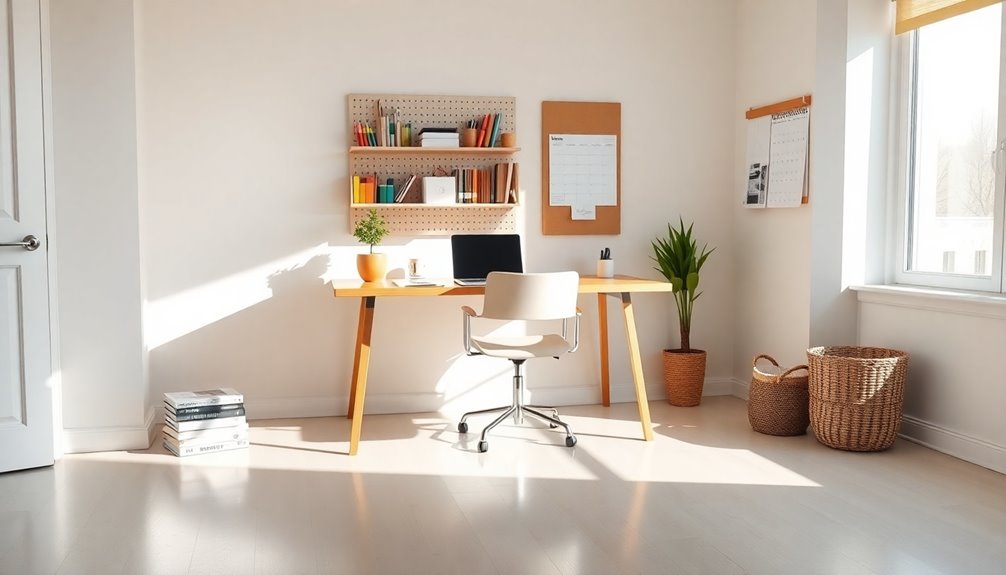
To keep your home office organized, set aside a specific time each day for cleanup.
Focus on quick tasks like tidying up papers and straightening supplies to make it efficient.
You can also involve others in the process, turning cleanup into a team effort that fosters a more organized space for everyone.
Set Cleanup Time Daily
Establishing a daily cleanup routine can transform your workspace in just 10 minutes. By scheduling a specific time each day, you'll create a habit that keeps clutter at bay.
This simple ritual sets you up for a new start each morning, enhancing your focus and efficiency. Plus, it's proven that dedicating time to declutter can reduce stress levels considerably. Incorporating deep breathing techniques while tidying can further enhance relaxation and promote a calm environment.
To help you stick to this routine, consider these tips:
- Use timers or reminders to stay on track
- Tidy up near natural light for a revitalizing ambiance
- Incorporate a calming playlist while cleaning
- Make it a family activity for shared responsibility
- Reflect on progress before going back to work
With consistency, you'll enjoy a more organized and productive space!
Prioritize Quick Organizing Tasks
After you've set aside time each day for cleanup, it's important to prioritize quick organizing tasks that keep your workspace neat and efficient.
Implement the "one-in, one-out" rule to prevent clutter; when you bring in a new item, remove another. It's hard to keep things organized if you don't have a color scheme for your materials, making it easier to find what you need at a glance.
Create a to-do list to focus on essential tasks, clearing both physical and digital clutter. Remember to return items to their designated spots immediately after use; this simple habit prevents accumulation.
Finally, dedicate a few minutes weekly to reassess your workspace, ensuring everything has a specific home for ongoing clarity. Additionally, keeping your workspace organized can help reduce stress and improve focus, much like how a consistent bedtime routine can promote better sleep for newborns.
Encourage Household Participation
While maintaining an organized home office can feel overwhelming, encouraging everyone in the household to participate in daily cleanup routines can make a significant difference. By designating specific times, like 10-15 minutes each evening, you can prevent clutter from piling up.
Consider these strategies to foster participation:
- Create visual reminders such as checklists or charts.
- Incorporate a reward system for consistent cleanup efforts.
- Lead by example by actively engaging in the cleanup.
- Set clear expectations for each person's responsibilities.
- Celebrate small victories to reinforce positive habits.
- Engaging in these routines can also promote emotional well-being, similar to the benefits observed in pet therapy for individuals with dementia and Parkinson's.
Keep Essential Tools Within Reach
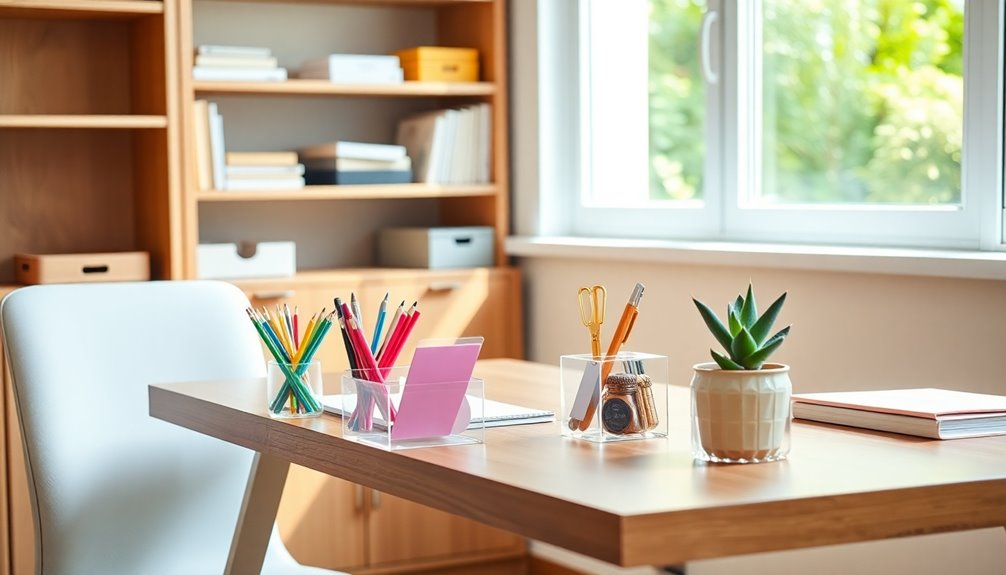
To enhance your productivity, it's crucial to keep essential tools within reach. Designate a specific spot on your desk for frequently used items like pens, notepads, and your planner. This simple organization can streamline your workflow and reduce the time spent searching for tools.
Utilize drawer organizers or small trays to keep these items easily accessible and prevent clutter from accumulating. For digital devices like chargers and headphones, use cable management solutions to avoid tangles and maintain a tidy workspace.
Store essential documents and reference materials in a desktop file organizer, ensuring you can quickly locate important information. Regularly assess your workspace to keep only the tools you use daily within reach, promoting an efficient and focused work environment.
Create a Comfortable Atmosphere

Creating a comfortable atmosphere in your home office can greatly boost your productivity.
Start by optimizing your lighting conditions to reduce eye strain and enhance focus, then choose inspiring decor that motivates you.
Don't forget to invest in comfortable seating that supports long hours of work without discomfort. Additionally, consider incorporating natural elements into your space, as they promote tranquility and enhance visual appeal.
Optimize Lighting Conditions
Optimizing your lighting conditions can transform your home office into a more inviting and productive space.
Start by positioning your desk near windows to take advantage of natural light, which can enhance your mood and productivity by up to 15%. Incorporate adjustable desk lamps with warm LED bulbs to reduce eye strain during long study sessions. Use task lighting that focuses on your workspace to improve visibility and concentration.
Consider these tips:
- Choose cooler lighting (5000K-6500K) for alertness.
- Opt for warmer light (2700K-3000K) for a cozy vibe.
- Regularly clean lamps and windows for maximum light.
- Position lamps to minimize shadows on your work.
- Experiment with different setups to find what works best for you.
Choose Inspiring Decor
While your workspace might be functional, adding inspiring decor can elevate it into a space that sparks creativity and motivation. Surrounding yourself with meaningful artwork or personal photos evokes positive emotions, making you feel more connected and comfortable.
Incorporating plants not only beautifies your office but also improves air quality and reduces stress levels, creating a revitalizing atmosphere. Establishing a cohesive color scheme enhances visual harmony, promoting focus and a sense of calm while you work.
Ultimately, utilizing decor that reflects your style and passions helps you connect with your space, making it more enjoyable to spend time in. By choosing inspiring decor, you transform your workspace into a sanctuary of productivity and creativity.
Incorporate Comfortable Seating
When you invest in comfortable seating, you're not just enhancing your workspace; you're also prioritizing your well-being.
An ergonomic chair can greatly improve your posture during long hours, reducing the risk of strain. Adding cushions or lumbar support can make a big difference, allowing you to focus on tasks longer without discomfort.
Consider these options to create a cozy atmosphere:
- Ergonomic chairs for better posture
- Cushions for added comfort
- Recliners for flexible positioning
- Adjustable seating to cater to your needs
- Soft textures and colors to reduce stress
Embrace Minimalism in Office Decor

To create a productive home office, embracing minimalism in your decor can make a significant difference. Limit your decorative items to those that evoke joy or serve a purpose; this approach reduces distractions and enhances focus.
Studies show that a clutter-free workspace can boost productivity by up to 20%. Choose a cohesive color scheme to create a serene environment, as harmonious colors can improve mood and concentration.
Opt for multifunctional furniture, like desks with built-in storage, to maximize space while maintaining a minimalist look. Implement strict decluttering habits, reassessing your decor every few months, to reinforce a minimalist mindset.
This practice keeps your workspace organized and inspiring, ultimately fostering a more effective work environment.
Regularly Assess and Refresh Your Space
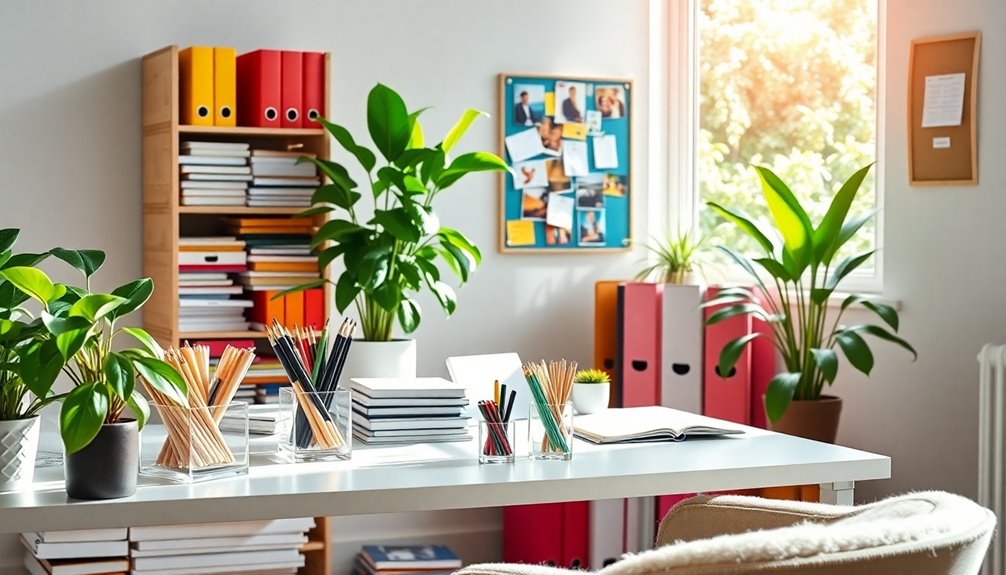
Regularly evaluating and revitalizing your space is essential for maintaining an efficient home office. Establish a routine, ideally each month, to tackle any clutter before it becomes overwhelming.
Assess how well your current organization systems are working, and make adjustments to enhance functionality. Dedicate a few minutes weekly to declutter and reorganize supplies for better accessibility.
Keep seasonal changes in mind to update your decor and organization methods as needed. Use a checklist to streamline your assessment process:
- Desk organization
- Paper management
- Digital file systems
- Unused items to declutter
- Accessibility of supplies
Frequently Asked Questions
How Do I Clear My Clutter and Get Organized?
To clear your clutter and get organized, start by setting up a designated file system for loose papers, making important documents easily accessible.
Create a daily to-do list to prioritize tasks and maintain focus.
Regularly purge expired products and unnecessary items from your workspace.
Establish specific zones for supplies, and tidy up your desk at the end of each day.
These steps will help you boost productivity and create a more efficient work environment.
How Do You Declutter and Organize a Home Office?
To declutter and organize your home office, start by assigning a specific spot for each item.
Use clear file storage systems for papers, keeping everything accessible. Incorporate baskets or drawer organizers for supplies to maintain a tidy workspace.
Schedule regular assessments to eliminate unnecessary items and practice end-of-day organization.
Cleaning your electronics weekly also helps create a fresh environment, boosting your productivity and ensuring your workspace remains functional and inviting.
How Do You Organize Clutter With ADHD?
To organize clutter with ADHD, start by breaking tasks into smaller steps.
Use colorful labels and checklists as visual reminders to track your progress.
Establish a consistent decluttering routine, making it a habit to minimize distractions.
Try the Pomodoro Technique to maintain focus during work sessions, followed by short breaks.
Create dedicated zones for different activities in your space, reducing visual clutter and helping you stay organized throughout your day.
How to Make an Office Look Less Cluttered?
Imagine walking into an office where everything's in its place, and the air feels lighter.
To make your office look less cluttered, start by utilizing vertical space with shelves or pegboards. Keep your desk clear by implementing drawer organizers and limiting decor to just a few inspiring pieces.
Establish a daily routine for tidying up and use cable management solutions to hide unsightly cords. You'll create a more inviting and productive workspace.
Conclusion
By following these organization hacks, you won't just transform your home office—you'll release a productivity superpower that could make you the next Einstein! Imagine a space so clear and focused that ideas burst forth like fireworks on New Year's Eve. Embrace the chaos-busting magic of decluttering, and watch as your creativity skyrockets to unimaginable heights. So, roll up your sleeves, immerse yourself, and let's turn that cluttered corner into a genius-enhancing sanctuary you'll never want to leave!
